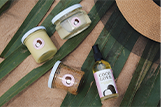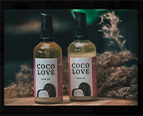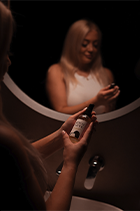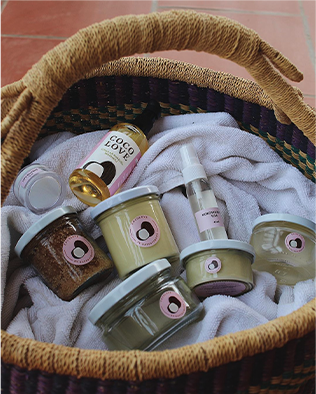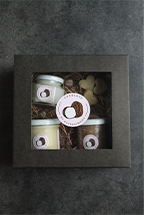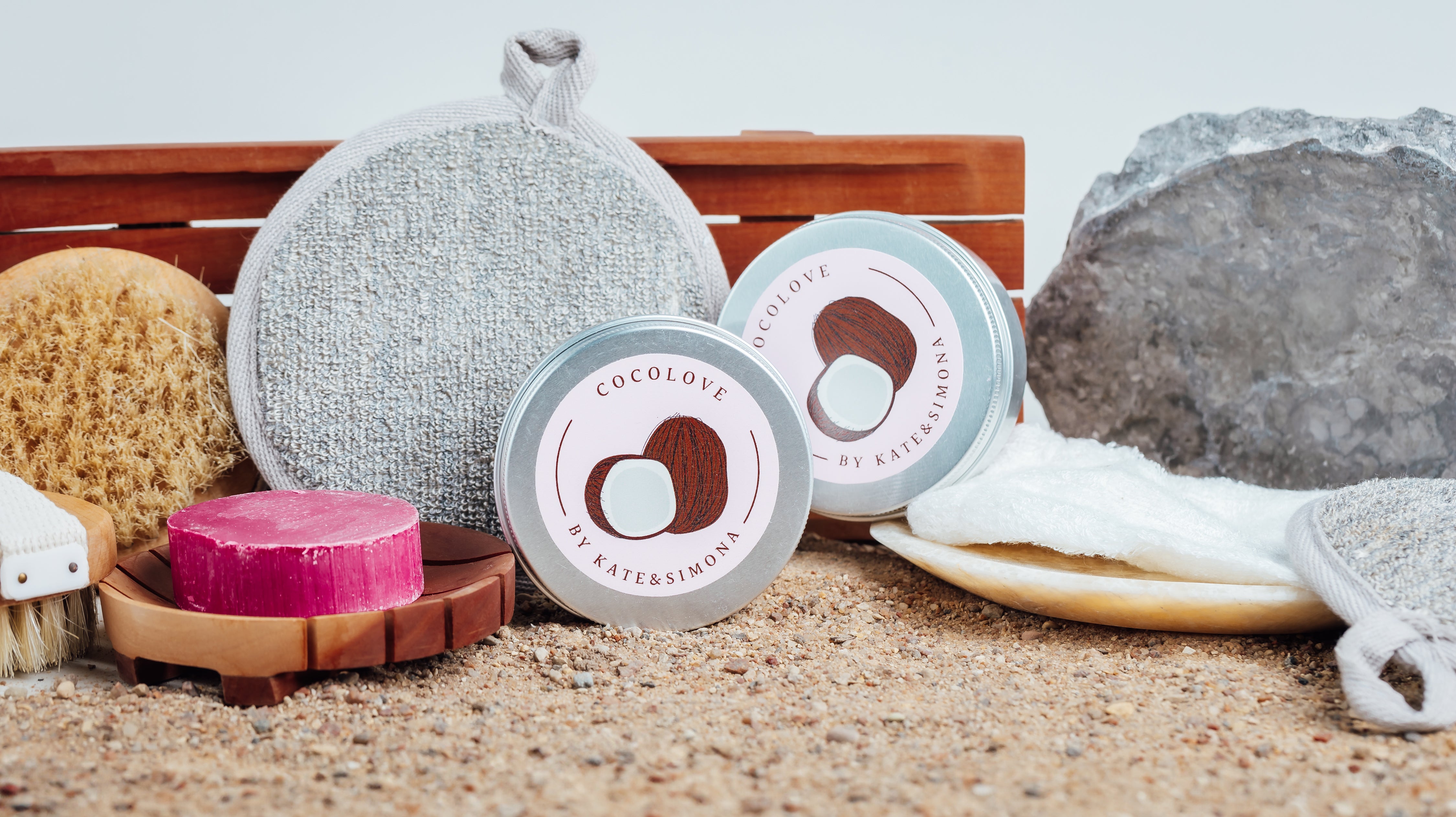Coconut oil for hair – will it help your hair too?

Coconut oil has become one of the most popular oils worldwide, and studies suggest that it can significantly reduce hair damage and improve hydration and nourishment. However, coconut oil may not always deliver the desired results for everyone. This is where the confusion lies – how do you determine if it’s the right choice for you?
Continue reading to find out how to use coconut oil for hair correctly, avoid disappointment, and maximize its potential!
Coconut oil in hair: why is it so valuable?
Coconut oil provides a range of benefits for hair care due to its unique composition. It contains a high amount of fatty acids, a small amount of vitamins, and antioxidants, making it an ideal product for improving hair health and appearance.
Medium-chain fatty acids (MCT) and lauric acid
Coconut oil is rich in medium-chain fatty acids (MCT), particularly lauric acid. This fatty acid helps penetrate deeply into the hair and moisturizes it from within.
According to studies, coconut oil, due to its lauric acid content, exhibits better penetration properties into the hair structure compared to other oils, such as sunflower or olive oil.
Vitamins and antioxidants
Coconut oil contains vitamin E, which acts as a powerful antioxidant, protecting hair from free radicals. It also contains a small amount of vitamin K, known for its ability to improve circulation, which can promote scalp health. Therefore, coconut oil can also be used for hair growth, especially when combined with a scalp massage.
Coconut oil has proven antioxidant activity, helping protect the hair structure and increasing its resistance to oxidative damage caused by factors such as UV rays and pollution.
Proteins
Proteins are the foundation of hair structure. Coconut oil for hair can help by reducing protein loss and preventing hair damage, especially when hair has been treated with chemicals or exposed to high temperatures.
A study revealed that coconut oil can penetrate deeply into the hair and prevent protein loss, compared to other oils such as mineral oil and soybean oil.
How else can it help?
Coconut oil for hair can assist not only with visual appearance but also with certain problems that can unexpectedly affect anyone.
Fighting dandruff and scalp fungal infections
Coconut oil deeply moisturizes the scalp and reduces inflammation, itching, and dryness, which are often associated with dandruff problems. Its antibacterial and soothing properties help balance the scalp’s microbiome and alleviate discomfort.
Coconut oil also has antifungal properties due to its high lauric acid content. A study published in the *Journal of Medicinal Food* demonstrated that coconut oil inhibits the growth of various fungi, including *Malassezia*.
Fighting lice
A study published in the *European Journal of Pediatrics* found that a mixture of coconut oil and anise seed was more effective against lice than chemical treatments with permethrin. This mixture killed lice and prevented re-infestation due to the oil's sticky properties and its ability to suffocate the parasites.
Is coconut oil suitable for all hair types?
Each hair type has a different structure and porosity, which directly affects the results of hair care. Coconut oil works best when the hair is not overly damaged and has a high porosity level.
COCOLOVE aims to provide a clear guide on whether coconut oil is truly suitable for your hair and how to use it most effectively, avoiding the most common mistakes.
High porosity hair
If you have porous hair, it means that the cuticles are open, and the hair is more susceptible to moisture. For this hair type, coconut oil can work very well, helping to restore moisture balance and reduce damage.
Low porosity hair
If you have low porosity hair, the cuticles are tightly closed, and the hair is less susceptible to moisture. For this hair type, coconut oil may be less effective as it absorbs more slowly and can leave the hair greasy. Instead, it's recommended to use lighter oils or moisturizers that provide hydration without adding extra weight.
How to determine hair porosity?
To determine how porous your hair is, you need to perform a few simple tests and pay attention to your hair's behavior and texture. Here is a step-by-step process on how to do it:
**Hair Water Test**
Take a few strands of clean, dry hair and place them in a glass of water.
- Low porosity hair**: The hair will float or take a long time to sink, as the cuticles are tightly closed and prevent moisture from entering easily.
- Medium porosity hair: The hair will sink slowly, as the cuticles are slightly open, allowing some moisture in but not too quickly.
- High porosity hair**: The hair will sink quickly because the cuticles are open and allow water to be absorbed easily.
Texture Test After Washing
When washing your hair, pay attention to the feeling of your hair when it is wet and still damp.
- Low porosity: The hair will feel very smooth, shiny, and easy to comb through, with no resistance.
- Medium porosity: The hair may feel slightly rough or textured, but it is still relatively easy to comb through.
- High porosity: The hair may feel dry, rough, and its structure fragile. It may tangle easily, create more resistance, and be difficult to detangle.
Moisturizing Product Absorption Test
Apply oil, serum, or another moisturizing product to damp hair and observe how quickly it absorbs.
- Low porosity: The hair absorbs products very slowly, and they tend to sit on the surface of the hair.
- Medium porosity: The hair absorbs products moderately, but not instantly.
- High porosity: The hair absorbs products quickly.
Reaction to Weather Conditions
Pay attention to the condition of your hair after prolonged sun exposure or humid weather.
-
Low porosity: Hair maintains its appearance and is less prone to fading or absorbing moisture.
-
Medium porosity: Hair may slightly change shape in humid weather but overall maintains its appearance.
-
High porosity: Hair quickly absorbs moisture during rain, becoming frizzy and losing its shape.
Visual assessment
Pay attention to the overall appearance and condition of your hair.
Low porosity: Hair is smooth, shiny, and shows no signs of split ends.
Medium porosity: Hair may be slightly dry or split, but overall it is not damaged.
High porosity: Hair is often dry, brittle, and has many split ends.
Depending on whether your hair has low, medium, or high porosity, natural unrefined coconut oil can be a great addition when used appropriately for your hair type.
Coconut Oil and Hair Types
Now that you've determined your hair porosity, let's take a look at how coconut oil works on different hair types.
| Hair type | The effects of coconut oil | Usage Recommendations |
| Dry and Damaged hair | Coconut oil deeply moisturizes, improves elasticity, and restores damaged structure by filling in the gaps in the hair cuticle layers, making the hair smoother, shinier, and softer. | Use 2-3 times a week as a mask or leave it overnight. |
| Greasy hair | Coconut oil can make hair heavier and greasier, potentially clogging the pores on the scalp. | Use a very small amount, focusing only on the ends of the hair. Avoid regular use. |
| Thin hair | Coconut oil provides protection and strengthening, but it’s important to be cautious to avoid weighing down the hair and losing volume. | Use only a small amount of oil, focusing on the hair ends, to maintain lightness. |
| Straight hair | Coconut oil adds shine and softness, preventing dryness and brittleness. | Use a very small amount, focusing on the hair ends, to avoid excessive flatness. |
| Wavy hair | Coconut oil improves hair texture, smooths the cuticles, and prevents frizz. | Use in moderation, focusing on the hair ends, to maintain volume. |
| Colored hair | Coconut oil prevents hair from drying out and damage, helping to preserve color. | Use after coloring to nourish and restore the hair, but be cautious with the amount to avoid diminishing the color's intensity. |
| Bleached hair | Coconut oil restores hair elasticity, nourishes, moisturizes, and protects from further damage. | Use as an overnight mask. Wash it out with shampoo in the morning. |
| Keratin-treated hair | Coconut oil helps maintain hair health, but it should be used sparingly to avoid reducing the longevity of keratin treatments. |
Use only a small amount to avoid reducing the effectiveness of the keratin treatment. |
Use this table to achieve the desired result, according to your hair type.
How to Use Coconut Oil for Hair:
The first step is to determine your hair's porosity and type, as this affects how effectively coconut oil absorbs and works. Next, for optimal results, hair care with coconut oil requires a few additional conditions to make the treatment even more effective.
Warm the oil before applying it
To improve the absorption of coconut oil into the hair and scalp, it is recommended to gently warm it to body temperature. Warm oil helps open the hair cuticles and ensures deeper nourishment.
Apply the coconut oil by gently spreading it through the hair, then wrap your head with a warm, damp towel or put on a shower cap. You can also use a hairdryer on the lowest heat setting, ensuring it doesn’t exceed 150°C. This steaming effect will help open the hair cuticles, allowing the oil to penetrate even deeper.
Combine with other natural ingredients
Coconut oil also works effectively as part of a hair mask combined with other natural ingredients such as honey, avocado, or lemon juice. These ingredients not only enhance the moisturizing effect of coconut oil but also provide additional nourishment and protection.
Check out the COCOLOVE hair mask recipes section and try different natural options.
Coconut oil in hair overnight
If you want to achieve even better results, coconut oil can be used as an overnight hair mask. Apply a small amount of oil before going to bed and wash it out with shampoo in the morning. This approach allows the hair to fully absorb the nourishing properties of the oil while you sleep.
The prolonged application of the oil helps coconut oil to more effectively penetrate the hair cuticles, improving elasticity and structure. However, it's important to thoroughly wash out the excess oil afterward and apply a light conditioner.
Choose high-quality virgin coconut oil
It is essential to choose high-quality coconut oil that is organic, cold-pressed, unrefined, and free from chemical additives. Only such oil will provide the best results and ensure that your hair receives all the necessary nutrients, which cannot be found in cheaper, processed products.
COCOLOVE coconut oil is exactly that—cold-pressed, unrefined, and natural, sourced from communities in Ghana, Africa, where the ideal conditions for palm and coconut growth ensure it retains all its nourishing properties.
Common Mistakes and How to Avoid Them
Coconut oil is an excellent hair care product when used correctly. Let’s take a look at the most common mistakes and provide solutions so you can be sure how to use coconut oil for your hair without damaging it.
Using too much product
One of the most common mistakes is using too much coconut oil. This can make hair heavy, greasy, and still feel dirty after washing. An excessive amount of oil can also contribute to quicker oiliness.
Apply a small amount of oil and gradually increase the amount if needed. It’s better to start with less and adjust as necessary than to overdo it from the beginning.
Inappropriate frequency of use
Although coconut oil is highly nourishing, excessive use can lead to greasy hair and even clogged pores on the scalp.
If your hair is dry and damaged, using oil two to three times a week can yield excellent results. However, if your hair is healthy and well-moisturized, once a week or less is sufficient.
Excessive use of heat
If you tend to use oil and then apply hot tools, hoping it will enhance the results, you might end up with the opposite effect. Excessive heat can destroy the nourishing properties of coconut oil and cause hair damage.
Avoid setting the heat above 150 degrees Celsius, as that is the maximum heat tolerance level for coconut oil.
Coconut oil for hair – where to buy?"
If you want to buy high-quality coconut oil, make sure to choose products that are pure, additive-free, and sourced in a traditional way. COCOLOVE offers 100% natural coconut oil from communities in Ghana, Africa, ensuring authenticity and sustainability.
We offer coconut oil in both glass jars and convenient spray bottles for easy and precise application. Our range also includes products where coconut oil is blended with other oils and butters, providing even greater hydration and nourishment.
We also have beautifully packaged gift sets, making them a perfect choice for treating yourself or surprising loved ones and friends.
Remember – we are all unique, and our care routine should be tailored to our individual needs. The secret to beautiful hair lies in care, knowledge, and choosing the right products.
Are you ready to try COCOLOVE coconut oil for your hair and see how it can improve your hair’s health and shine? 🥥
